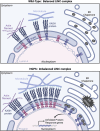Life at the crossroads: the nuclear LINC complex and vascular mechanotransduction
- PMID: 38831796
- PMCID: PMC11144885
- DOI: 10.3389/fphys.2024.1411995
Life at the crossroads: the nuclear LINC complex and vascular mechanotransduction
Abstract
Vascular endothelial cells line the inner surface of all blood vessels, where they are exposed to polarized mechanical forces throughout their lifespan. Both basal substrate interactions and apical blood flow-induced shear stress regulate blood vessel development, remodeling, and maintenance of vascular homeostasis. Disruption of these interactions leads to dysfunction and vascular pathologies, although how forces are sensed and integrated to affect endothelial cell behaviors is incompletely understood. Recently the endothelial cell nucleus has emerged as a prominent force-transducing organelle that participates in vascular mechanotransduction, via communication to and from cell-cell and cell-matrix junctions. The LINC complex, composed of SUN and nesprin proteins, spans the nuclear membranes and connects the nuclear lamina, the nuclear envelope, and the cytoskeleton. Here we review LINC complex involvement in endothelial cell mechanotransduction, describe unique and overlapping functions of each LINC complex component, and consider emerging evidence that two major SUN proteins, SUN1 and SUN2, orchestrate a complex interplay that extends outward to cell-cell and cell-matrix junctions and inward to interactions within the nucleus and chromatin. We discuss these findings in relation to vascular pathologies such as Hutchinson-Gilford progeria syndrome, a premature aging disorder with cardiovascular impairment. More knowledge of LINC complex regulation and function will help to understand how the nucleus participates in endothelial cell force sensing and how dysfunction leads to cardiovascular disease.
Keywords: LINC complex; SUN protein; cytoskeleton; endothelial cell; lamin; mechanotransduction; nucleus; vascular disease.
Copyright © 2024 Bougaran and Bautch.
Conflict of interest statement
The authors declare that the research was conducted in the absence of any commercial or financial relationships that could be construed as a potential conflict of interest.
Figures



Similar articles
-
Global loss of a nuclear lamina component, lamin A/C, and LINC complex components SUN1, SUN2, and nesprin-2 in breast cancer.Cancer Med. 2015 Oct;4(10):1547-57. doi: 10.1002/cam4.495. Epub 2015 Jul 14. Cancer Med. 2015. PMID: 26175118 Free PMC article.
-
Nesprin-2G, a Component of the Nuclear LINC Complex, Is Subject to Myosin-Dependent Tension.Biophys J. 2016 Jan 5;110(1):34-43. doi: 10.1016/j.bpj.2015.11.014. Biophys J. 2016. PMID: 26745407 Free PMC article.
-
Inner Nuclear Membrane Protein, SUN1, is Required for Cytoskeletal Force Generation and Focal Adhesion Maturation.Front Cell Dev Biol. 2022 May 18;10:885859. doi: 10.3389/fcell.2022.885859. eCollection 2022. Front Cell Dev Biol. 2022. PMID: 35663386 Free PMC article.
-
Endothelial Nuclear Lamina in Mechanotransduction Under Shear Stress.Adv Exp Med Biol. 2018;1097:83-104. doi: 10.1007/978-3-319-96445-4_5. Adv Exp Med Biol. 2018. PMID: 30315541 Review.
-
Nuclear envelope components in vascular mechanotransduction: emerging roles in vascular health and disease.Nucleus. 2025 Dec;16(1):2453752. doi: 10.1080/19491034.2025.2453752. Epub 2025 Jan 19. Nucleus. 2025. PMID: 39827403 Review.
Cited by
-
Splitting Haploid Chromosomes into Different Nuclei: New Mechanisms of Adaptation in Fungi?J Fungi (Basel). 2025 Aug 21;11(8):606. doi: 10.3390/jof11080606. J Fungi (Basel). 2025. PMID: 40863557 Free PMC article.
-
Mechanical Forces, Nucleus, Chromosomes, and Chromatin.Biomolecules. 2025 Mar 1;15(3):354. doi: 10.3390/biom15030354. Biomolecules. 2025. PMID: 40149890 Free PMC article. Review.
-
Mechanotransduction of the vasculature in Hutchinson-Gilford Progeria Syndrome.Front Physiol. 2024 Aug 22;15:1464678. doi: 10.3389/fphys.2024.1464678. eCollection 2024. Front Physiol. 2024. PMID: 39239311 Free PMC article. Review.
References
-
- Atchison L., Abutaleb N. O., Snyder-Mounts E., Gete Y., Ladha A., Ribar T., et al. (2020). iPSC-derived endothelial cells affect vascular function in a tissue-engineered blood vessel model of hutchinson-gilford progeria syndrome. Stem Cell Rep. 14, 325–337. 10.1016/j.stemcr.2020.01.005 - DOI - PMC - PubMed
-
- Banerjee I., Zhang J., Moore-Morris T., Pfeiffer E., Buchholz K. S., Liu A., et al. (2014). Targeted ablation of nesprin 1 and nesprin 2 from murine myocardium results in cardiomyopathy, altered nuclear morphology and inhibition of the biomechanical gene response. PLoS Genet. 10, e1004114. 10.1371/journal.pgen.1004114 - DOI - PMC - PubMed
Publication types
LinkOut - more resources
Full Text Sources
Miscellaneous

